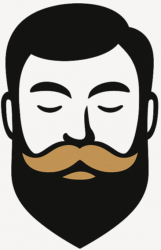
Uneven Beard Growth: You’re Not Alone
Almost every man experiences uneven beard growth at some point. Whether it’s thinner spots on the cheeks, one side growing faster, or stubborn patches under the chin, it’s completely normal. Beard growth isn’t perfectly symmetrical because your hair follicles, hormones, and genetics don’t work in perfect balance — and that’s okay.
Common Reasons Your Beard Grows Unevenly
1. Genetics
Your DNA determines how many follicles you have and how active they are. Some areas simply produce thicker, faster-growing hair, while others are sparse by nature.
2. Hormones
Testosterone and DHT (dihydrotestosterone) play a major role in beard density. Even small hormonal variations can cause uneven growth patterns over time.
3. Stress and Sleep
Poor sleep or chronic stress can slow beard growth and increase shedding. Your body prioritizes essential functions over hair growth when under pressure.
4. Nutrition Deficiency
Lacking vitamins like biotin, B12, zinc, or vitamin D can lead to slower or patchy beard growth. Proper nutrition supports healthy follicles and consistent growth.
5. Grooming Habits
Over-trimming or shaving too frequently can exaggerate uneven growth, especially if one side is consistently cut shorter.
6. Circulation and Skin Health
Uneven circulation, dry skin, or clogged pores can restrict hair growth in certain areas. Regular exfoliation and moisturizing can help balance follicle activity.
How to Fix an Uneven Beard
1. Let It Grow
Give it time — at least 6–8 weeks without trimming. You may be surprised how the slower-growing areas fill in with patience.
2. Train Your Beard
Use a boar bristle brush daily to direct growth and distribute oils evenly. Consistency helps your beard look fuller and more uniform.
3. Apply Beard Oil or Balm
Hydrated follicles produce healthier, stronger hair. Oils rich in argan, jojoba, or castor oil can improve the appearance of patchy areas.
4. Adjust Your Diet
Eat foods high in protein, healthy fats, and vitamins that support hair health — like eggs, nuts, and leafy greens.
5. Consider Beard Styling Tricks
Shape your beard to minimize patchiness — shorter on thicker areas and longer where hair grows slower.
When to Seek Help
If uneven growth suddenly worsens, you experience bald spots, or the skin feels inflamed, consider seeing a dermatologist. Sometimes underlying conditions like alopecia or hormonal imbalances can contribute.
Final Thoughts
An uneven beard isn’t a flaw — it’s part of your beard’s natural character. With patience, proper care, and smart grooming, you can achieve a balanced, confident look that fits your face perfectly. Remember: even the most iconic beards started out imperfect.
